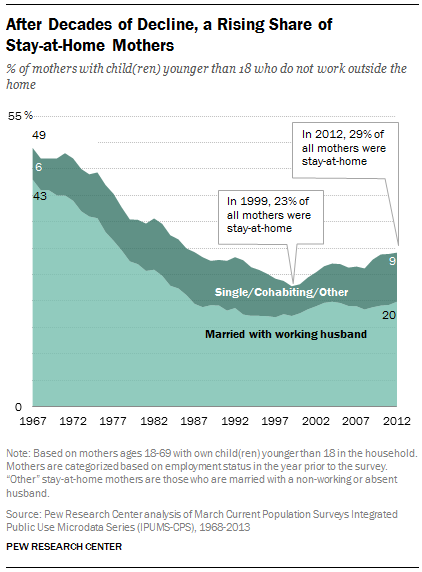Stay-At-Home Mothers Are Back On The Rise: Why More Women Are Ditching Corporate Life To Care For Their Families

Following a dramatic decline in the number of stay-at-home mothers from over 40 percent of women with children under the age of 18 in 1970 to 23 percent in 1999, it seems this demographic is back on the rise. According to a report conducted by the Pew Research Center, the number of mothers abandoning life at the office to take care of matters in the household has risen back up to 29 percent after over three decades of gradual regression.

The research team from Pew’s Social & Demographic Trends department gathered data through the Current Population Survey (CPS) and the American Time Use Survey (ATUS). Based on 90,000 household interviews in 2013, the CPS is based off statistics from the U.S. Census Bureau and the Bureau of Labor Statistics’ 1971-2013 Annual Social and Economic Supplement (ASEC). Launched in 2003 by the Bureau of Labor Statistics, the ATUS is considered the nation’s largest survey on time use. Pew based its assessment on women between the ages of 18 and 69 with at least one child under the age of 18.
Results of Pew’s analysis revealed 10.4 million women stayed at home in 2012 because they were caring for their family, were unable to find work, were disabled, or were enrolled in school. Approximately two-thirds of this group were categorized as “traditional” stay-at-home moms who were married to a working husband. Twenty-five percent of mothers staying at home had graduated from college, while 19 percent did not receive their high school diploma. Researchers were surprised to learn that 34 percent of stay-at-home mothers were living in poverty compared to 12 percent of working mothers.
Certain age and racial disparities were all discovered through the course of the investigation. Forty-two percent of mothers devoted to their household were younger than 35 compared to 35 percent of working mothers. One of the factors Pew researchers said may have contributed to the overall rise in stay-at-home mothers is the growing number of Asian and Latino populations and the distribution of foreign mothers in the United States. Almost half of mothers without a current job were considered non-white while 33 percent were born outside of the U.S.

In a separate poll organized by the Pew Research Center, Americans were asked to give their opinion on stay-at-home and working mothers’ impact on their children. Sixty percent of individuals participating in the survey said a parent who can focus their time and attention on the household is better for a child’s well-being compared to 35 percent who said two working parents made no difference in the child’s upbringing. Half of Americans responding to the General Social Survey back in 1977 agreed that a working mother “can establish just as warm and secure a relationship with her children” as a mother who stays home.
Published by Medicaldaily.com



























